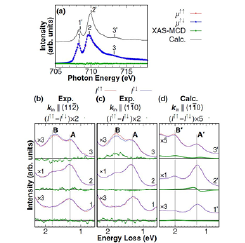Dzyaloshinskii-Moriya Interaction in α-Fe2O3 Measured by Magnetic Circular Dichroism in Resonant Inelastic Soft X-ray Scattering
Harada Group
Dzyaloshinskii-Moriya interaction (DMI) is an asymmetric exchange interaction induced by a lack of inversion symmetry in materials through spin-orbit coupling. Even though DMI is much weaker than the Heisenberg exchange interaction, DMI plays an essentially important role to determine magnetism and related physical properties in various systems. DMI is expressed by the formula Dij · Si × Sj, but the direction and magnitude of Dij has been difficult to determine both theoretically and experimentally. Among new approaches explored to measure DMI, selective observation of the electronic structure that is responsible for the DMI is of crucial importance. α-Fe2O3 is a prototype material of DMI and shows weak ferromagnetism due to the DMI at room temperature. However, even for α-Fe2O3, the electronic structure leading to its weak ferromagnetism has not been experimentally identified. Thus, we measured magnetic circular dichroism (MCD) in resonant inelastic soft x-ray scattering (SX-RIXS) of α-Fe2O3 [1]. RIXS-MCD enables us to probe the MCD for each dd excitation, which is very sensitive to the symmetry of the d orbitals, and is expected to give an insight into the origin of the weak ferromagnetism induced by DMI in α-Fe2O3.

Fig. 1. Experimental and calculated results of Fe L3-edge XAS- and RIXS-MCD spectra of α-Fe2O3. (a) Experimental and calculated Fe L3-edge XAS spectra. (b) and (c) Experimental RIXS-MCD spectra in the configurations of kin || 〈112〉 and kin || 〈110〉. (d) Calculated RIXS-MCD spectra in the configuration of kin || 〈110〉. The red (I↑↑) and blue (I↑↓) spectra represent the intensity of the scattered x ray for the spin polarization of the incident x ray parallel and antiparallel to the direction of the sample magnetization, respectively. The numbers in (b,c,d) indicate the excitation energies shown in (a).
The x-ray absorption spectra (XAS) and RIXS experiments of an α-Fe2O3 single crystal were conducted at the HORNET end-station at BL07LSU in SPring-8. MCD in XAS and RIXS was measured by using a compact magnetic circuit with permanent Nd-Fe-B magnets [2]. Figure 1(a) compares the experimental and calculated results of XAS of α-Fe2O3. Peak splittings (Nos. 1 and 2) attributed to the crystal field effect and a satellite feature at hν ≈ 713.25 eV assigned to a charge-transfer state were clearly observed. No discernible XAS-MCD signal was detected. XAS is well reproduced by ab initio charge-transfer multiplet calculation. Figures 1(b) and 1(c) show RIXS-MCD spectra measured by two different experimental configurations. In the configuration of kin ||〈112〉 (Fig. 1(b)), the magnitude of RIXS-MCD was relatively small at any excitation energies employed compared with that in the configuration of kin ||〈110〉 (Fig. 1(c)), where the dd excitation at 1.8 eV (peak B) showed RIXS-MCD for hν > 713.25 eV (No. 3, the charge-transfer satellite), while no RIXS-MCD was observed by the excitation of the main absorption peaks (Nos. 1 and 2). Thus, RIXS-MCD showed the crystal orientation and excitation energy dependences. The observed RIXS-MCD is qualitatively well described by the calculations (Fig. 1(d)). RIXS-MCD in peak B′ is almost absent for the excitations around the main peaks of the L3 edge (Nos. 1′ and 2′), while small but clear RIXS-MCD is found at peak B′ for the excitations above the satellite structure (No. 3′). The more detailed configuration analysis has revealed that the RIXS-MCD derives from spin flip excitations at delocalized eg orbitals. By the combination of the experiments and calculations, RIXS-MCD has unraveled that the origin of DMI in α-Fe2O3 is the eg orbitals, which are strongly hybridized with the 2p orbitals of oxygen atoms.
The results demonstrate the important capability of RIXS-MCD to sensitively extract the magnetic information from MCD of each dd excitation in the weak-ferromagnet, where the net magnetic moments are so small that XAS-MCD is not applicable. With this advantage, RIXS-MCD is expected to be more widely applied to the weak ferromagnetism and spin spiral induced by DMI. Furthermore, bulk sensitivity and element selectivity of RIXS will also promote the measurement of RIXS-MCD, and thus RIXS-MCD could be a promising technique to obtain the information about the ground-state spin state. Finally, it is worth mentioning that the computational calculations have now become powerful enough to discuss the very small magnitude of RIXS-MCD for the realistic low-symmetry system, and will advance the more precise analysis of the experimental results and give more complete comprehension of physical properties.
References
- [1] J. Miyawaki, S. Suga, H. Fujiwara, M. Urasaki, H. Ikeno, H. Niwa, H. Kiuchi, and Y. Harada, Phys. Rev. B 96, 214420 (2017).
- [2] J. Miyawaki, S. Suga, H. Fujiwara, H. Niwa, H. Kiuchi, and Y. Harada, J. Synchrotron Rad. 24, 449 (2017).
